中国文化_夏商周历史(英文)
第8课《夏商周时期的科技与文化》课件精品-七年级历史上册版

一、天文、历法和医学
1.天文成就:
目的
①背景:原始社会末期先民们为从事农业生产,对天文现象进行观察和记录,总结日 月星辰的运行规律。 ②商朝甲骨文里有许多日食、月食的记载
③西周《诗经》中记载了公元前776年9月6日发生日食,这是我国历史上第一次有确切
日期的日食记录 ④春秋《春秋》中记载了公元前613年一颗彗星扫过北斗,这是关于哈雷彗星最早
看谁认得多
商 林田单水 家 休 后 从 门 鱼 眉 山 束 地位:甲骨文已经具备了汉字的基本结构,是汉字发展的重要阶段,也是
我国已发现的古代文字中年代最早、体系较为完整的成熟文字。
二、甲骨文与青铜器
甲骨文意义:
①甲骨文已经具备了汉字的基本结构,是汉字发展的重要阶段, ②是我国已发现的古代文字中年代最早、体系较为完整的成熟文字。 ③目前所知,我国有文字可考的历史从商朝开始。
的确切记载
天文
记载日 食的商 朝牛骨
殷商武丁时期 的一根卜骨, 上面的刻辞为 “旬壬申夕, 月有食”。
十月之交, 朔月辛卯。 日有食之, 亦孔之丑。 —《诗经》
原始社会末期
商朝
周朝
春秋
一、天文、历法和医学
2.历法成就:
①夏朝: 相传夏朝时就有了历法;
②商朝:历法逐渐完备,一年分为12个月,大月30天,小 月29天,闰年增加一个月;
材料:惟殷先人,有典有册。
传说时代:口耳相传
——《尚书》
文明时代:文字记录
口耳相传
结绳记事
原始刻画符号
甲骨文
二、甲骨文与青铜器
2.青铜器
(1)概念:青铜器,在古时被称为“金”或“吉金”,是红铜与其他化学元 素锡、铅等的合金。刚刚铸造完成的青铜器是金色的,但出土的青
夏、商、周三族种系构成研究:兼论华夏族系的起源
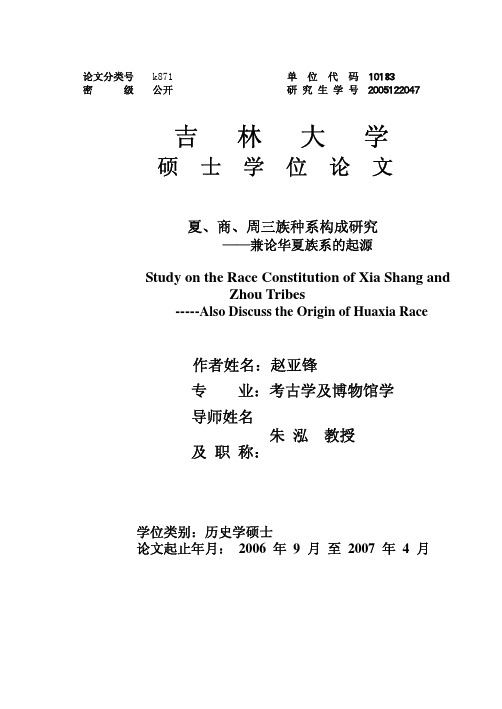
论文分类号 k871 单位代码10183密级公开研究生学号2005122047吉林大学硕士学位论文夏、商、周三族种系构成研究——兼论华夏族系的起源Study on the Race Constitution of Xia Shang andZhou Tribes-----Also Discuss the Origin of Huaxia Race作者姓名:赵亚锋专业:考古学及博物馆学导师姓名朱泓教授及职称:学位类别:历史学硕士论文起止年月: 2006 年 9 月至 2007 年 4 月吉林大学硕士学位论文原创性声明本人郑重声明:所呈交的硕士学位论文,是本人在指导教师的指导下,独立进行研究工作所取得的成果。
除文中已经注明引用的内容外,本论文不包含任何其他个人或集体已经发表或撰写过的作品成果。
对本文的研究做出重要贡献的个人和集体,均已在文中以明确方式标明。
本人完全意识到本声明的法律结果由本人承担。
学位论文作者签名:赵亚锋日期: 2007年 4 月 22 日《中国优秀博硕士学位论文全文数据库》投稿声明研究生院:本人同意《中国优秀博硕士学位论文全文数据库》出版章程的内容,愿意将本人的学位论文委托研究生院向中国学术期刊(光盘版)电子杂志社的《中国优秀博硕士学位论文全文数据库》投稿,希望《中国优秀博硕士学位论文全文数据库》给予出版,并同意在《中国博硕士学位论文评价数据库》和CNKI系列数据库中使用,同意按章程规定享受相关权益。
√论文级别:□硕士□博士学科专业:考古学及博物馆学论文题目:夏、商、周三族种系构成研究——兼论华夏族系的起源作者签名:赵亚锋指导教师签名:朱泓2007 年 4 月 22 日作者联系地址(邮编):吉林大学边疆考古研究中心(130012)作者联系电话:130****2372作者姓名赵亚锋论文分类号 K871 保密级别公开研究生学号 2005122047 学位类别历史学硕士授予学位单位吉林大学专业名称考古学及博物馆学培养单位(院、所、中心)吉林大学边疆考古研究中心研究方向体质人类学学习时间2005年9月至2007年7月论文中文题目夏、商、周三族种系构成研究论文英文题目Study On the Race Constitution of Xia Shang andZhou Tribes关键词(3-8个)种系构成多元统计先秦古人种类型分布起源姓名朱泓职称教授导师情况学历学位历史学博士工作单位吉林大学边疆考古研究中心论文提交日期 2007年4月25日答辩日期2007年6月日是否基金资助项目否基金类别及编号如已经出版,请填写以下内容出版地(城市名、省名)出版者(机构)名称出版日期出版者地址(包括邮编)内容提要在先秦古人种类型分布框架下,利用多元统计之聚类分析和主成份分析的方法,对夏人、商人和周人的种系构成及种系渊源情况进行研究,最后结果显示:夏人、周人和居多数的商人在体质类型上具有同一性,皆可归入先秦古人种类型中的“古中原类型”,但其彼此间又有一定的差异,商人中的中小墓③组属“古东北类型”;周人瓦窑沟组在面部形态上可以看到“古西北类型”的影响。
中国文化的各个时期

中国文化的各个时期1.三代(夏商周):中国古代文化的雏形开始形成,可称为中国古代文化的“源头”,与这个源头联系比较密切的文化热点就是“夏商周断代工程”。
仅就中国文化“源头”看,重点掌握三个方面:—是记录和传播文化的载体趋向成熟----文字(甲骨文),形成了中华文化独具特色的语言文字。
二是创立了记录时间的方法——干支纪日法,中华民族对历史的变迁有了明确的时间观念。
三是形成了认识世界的哲学方法——《易》。
重点是古人的朴素辩证法思想,和“天行健、君子以自强不息”的精神,是中国古代文化的突出代表。
2.春秋战国时期:中国古代文化的全面奠基时期。
形成了中国古代文化的“灵魂”,产生了中国古代文化两位杰出的“形象代言人”:老子和孔子。
反映了古人对自然、人生和社会的几类不同的思考,主要是儒家思想、墨家思想、道家思想和法家思想,对中华民族的发展产生了重要影响,形成了中华民族精神的主要内容。
3.秦汉时期:是中国古代文化的丰富和发展时期。
科技文化大发展,统一性与多样性向结合,奠定了中国科技文化在世界上的领先地位。
为后世文化的进一步发展奠定了基础。
这个时期的文化体现了统一多民族中央集权国家建立之初奋发向上的精神面貌和统一王朝的恢弘气度。
突出代表:气势雄伟的万里长城(长城精神)、威武气派的秦始皇兵马俑和贯通古今的《史记》,思想上的大—统。
尤其是《汉武大帝》的热播,与之有关的内容应引起一定的重视。
4.三国两晋南北朝时期:“秦汉文化高潮过去后的平淡”,相对于前一个阶段,少了些气势,多了些平淡与细腻。
具体表现:文化科技继续进步,思想方面儒、道、释开始互相渗透,佛教盛行、艺术异彩纷呈,具有鲜明的民族融合特色。
5.隋唐时期:中国封建社会的鼎盛带来古代文化的全面辉煌。
兼收并蓄、全面辉煌、泽被后人、影晌周边,世界领先、地位突出(在中国文化史上),是中国古代文化辉煌的代表。
6.宋元时期:中国古代文化的又一高峰。
中国传统科技的代表四大发明中有三大发明在这个阶段,商品经济对文学艺术的影响凸显,是中国古代文化发展中的新现象,应引起重视。
中国历史文化常识大全集
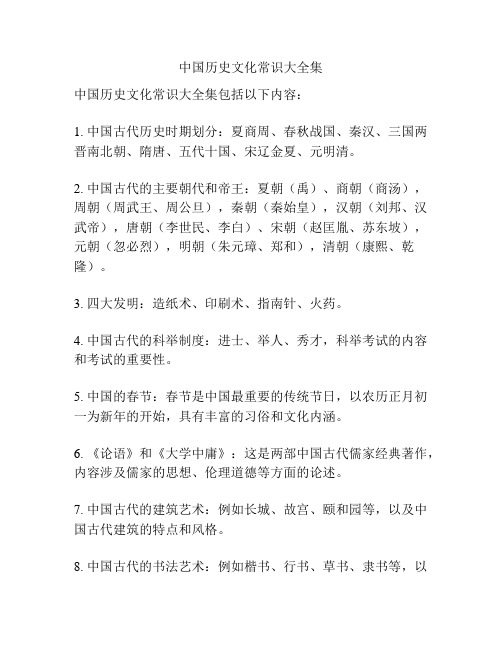
中国历史文化常识大全集中国历史文化常识大全集包括以下内容:1. 中国古代历史时期划分:夏商周、春秋战国、秦汉、三国两晋南北朝、隋唐、五代十国、宋辽金夏、元明清。
2. 中国古代的主要朝代和帝王:夏朝(禹)、商朝(商汤),周朝(周武王、周公旦),秦朝(秦始皇),汉朝(刘邦、汉武帝),唐朝(李世民、李白)、宋朝(赵匡胤、苏东坡),元朝(忽必烈),明朝(朱元璋、郑和),清朝(康熙、乾隆)。
3. 四大发明:造纸术、印刷术、指南针、火药。
4. 中国古代的科举制度:进士、举人、秀才,科举考试的内容和考试的重要性。
5. 中国的春节:春节是中国最重要的传统节日,以农历正月初一为新年的开始,具有丰富的习俗和文化内涵。
6. 《论语》和《大学中庸》:这是两部中国古代儒家经典著作,内容涉及儒家的思想、伦理道德等方面的论述。
7. 中国古代的建筑艺术:例如长城、故宫、颐和园等,以及中国古代建筑的特点和风格。
8. 中国古代的书法艺术:例如楷书、行书、草书、隶书等,以及中国古代书法家的代表作品。
9. 中国古代的绘画艺术:例如山水画、花鸟画、人物画等,以及中国古代画家的代表作品。
10. 中国的传统音乐:例如京剧、昆曲、评剧等,以及中国传统音乐的特点和韵律。
11. 中国的传统节日:例如清明节、端午节、中秋节等,以及这些节日的由来和庆祝方式。
12. 中国的传统服饰:例如汉服、唐装等,以及中国传统服饰的特点和变迁。
13. 中国的传统饮食文化:例如米饭、面条、饺子等,以及中国传统饮食的特点和习俗。
14. 中国的传统医学:例如中药、针灸等,以及中国传统医学的理论和应用。
15. 中国的传统工艺品:例如瓷器、丝绸、剪纸等,以及这些工艺品的制作工艺和艺术价值。
这些只是中国历史文化常识的一小部分,涵盖范围非常广泛。
中国夏商周时期的历史事件时间轴
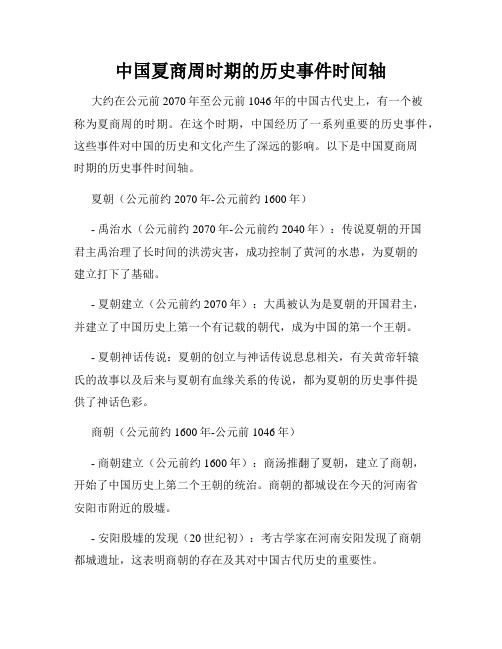
中国夏商周时期的历史事件时间轴大约在公元前2070年至公元前1046年的中国古代史上,有一个被称为夏商周的时期。
在这个时期,中国经历了一系列重要的历史事件,这些事件对中国的历史和文化产生了深远的影响。
以下是中国夏商周时期的历史事件时间轴。
夏朝(公元前约2070年-公元前约1600年)- 禹治水(公元前约2070年-公元前约2040年):传说夏朝的开国君主禹治理了长时间的洪涝灾害,成功控制了黄河的水患,为夏朝的建立打下了基础。
- 夏朝建立(公元前约2070年):大禹被认为是夏朝的开国君主,并建立了中国历史上第一个有记载的朝代,成为中国的第一个王朝。
- 夏朝神话传说:夏朝的创立与神话传说息息相关,有关黄帝轩辕氏的故事以及后来与夏朝有血缘关系的传说,都为夏朝的历史事件提供了神话色彩。
商朝(公元前约1600年-公元前1046年)- 商朝建立(公元前约1600年):商汤推翻了夏朝,建立了商朝,开始了中国历史上第二个王朝的统治。
商朝的都城设在今天的河南省安阳市附近的殷墟。
- 安阳殷墟的发现(20世纪初):考古学家在河南安阳发现了商朝都城遗址,这表明商朝的存在及其对中国古代历史的重要性。
- 商代青铜文化:商朝是中国青铜文化的鼎盛时期,青铜器在社会、礼仪和冥仪中起到了重要的作用,对后来的文化和艺术产生了深远的影响。
周朝(公元前约1046年-公元前256年)- 周朝建立(公元前约1046年):周武王推翻了商朝的统治,建立了周朝,开始了中国历史上第三个王朝的统治。
周朝的都城设在今天的陕西省西安市附近的咸阳。
- 封建制度的确立:周朝实行了严格的封建制度,分封诸侯,以保持王权的稳定和统一。
- 春秋战国时期(公元前771年-公元前256年):周朝后期出现了诸多国家的兴起,这是中国历史上一个重要的转折点,也是中国战国时期的起点。
- 孔子的思想(公元前551年-公元前479年):孔子是中国古代著名的思想家和教育家,他的思想影响了中国历史的发展,并成为后来中国文化的重要组成部分。
周朝历史介绍英文作文范文
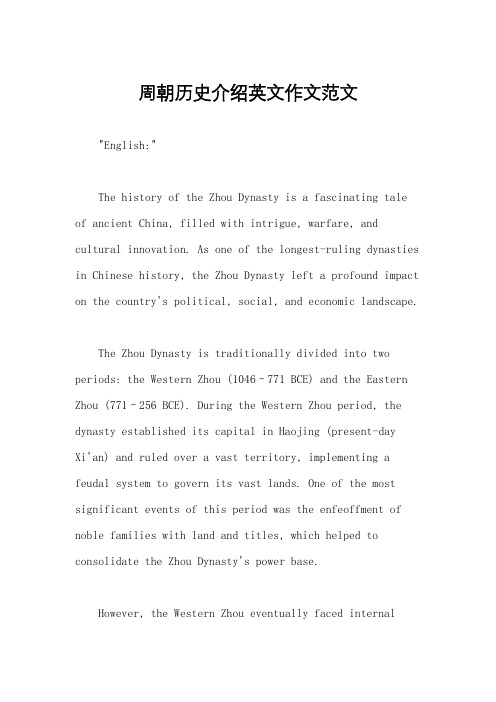
周朝历史介绍英文作文范文"English:"The history of the Zhou Dynasty is a fascinating tale of ancient China, filled with intrigue, warfare, and cultural innovation. As one of the longest-ruling dynasties in Chinese history, the Zhou Dynasty left a profound impact on the country's political, social, and economic landscape.The Zhou Dynasty is traditionally divided into two periods: the Western Zhou (1046–771 BCE) and the Eastern Zhou (771–256 BCE). During the Western Zhou period, the dynasty established its capital in Haojing (present-dayXi'an) and ruled over a vast territory, implementing a feudal system to govern its vast lands. One of the most significant events of this period was the enfeoffment of noble families with land and titles, which helped to consolidate the Zhou Dynasty's power base.However, the Western Zhou eventually faced internalstrife and external threats, leading to its decline. The Eastern Zhou period is further divided into the Spring and Autumn Period (770–476 BCE) and the Warring States Period (475–221 BCE). These eras were characterized by increasing decentralization of power, as regional lords gained autonomy and competed for dominance. The philosopher Confucius lived during the Spring and Autumn Period, and his teachings on ethics and governance continue to influence Chinese culture to this day.中文:周朝的历史是中国古代的一个迷人故事,充满了阴谋、战争和文化创新。
先讲三皇五帝夏商周,再谈解放以后三十年。

先讲三皇五帝夏商周,再谈解放以后三十年一、三皇五帝夏商周中国历史悠久,最早的历史文化可以追溯到三皇五帝时期,大约在公元前5000年左右。
据史书记载,远古时代,中国大陆上最早的国家是“The Three August Ones and Five Emperors”(三皇五帝)。
他们是中国史前时期的传说人物,包含着极其丰富的历史文化内涵。
1.1 三皇五帝的介绍三皇,指的是伏羲、神农、黄帝,他们是先民时期的领袖人物。
五帝,是指轩辕、颛顼、帝喾、尧和舜(依出生先后排序)。
他们是中国古代统治者的代表,各自在各自的时代创造了辉煌的文明。
1.1.1 伏羲伏羲是汉族人民的祖先,号称“万物之祖”。
传说伏羲亲手刻制了八卦图、六十花甲、相生相克等文化符号,是中国古代文明的奠基人之一。
1.1.2 神农神农是农业文明的创始人,他创造了农具,为人类社会铺平了农业发展的道路。
此外,神农还系统地研究了中药,因此被尊称为“神医”。
1.1.3 黄帝黄帝是中国最早的帝王之一,也是“五帝”中的一员。
黄帝以智慧和勇气著称,他在位期间创制了书法、乐曲和武术,为后世留下了宝贵的文化遗产。
1.1.4 轩辕轩辕是中国古代的黄帝时期的英雄人物,他是古代军事家和政治家,也是中国古代制陶业的开创者。
他发明了炉子和炭火,是中国古代文明的重要贡献者之一。
1.1.5 颛顼颛顼是一位智慧和胆识兼备的人物,在中国古代的商代时期,颛顼曾经挑战魏国,是当时中国的一位伟大将领和政治家。
1.1.6 帝喾帝喾是经受过战争历练的将领,也是文化人,他在整合和巩固部落的过程中,倡导了多元文化,从而推动了中华文化的发展。
在中国古代历史上,帝喾被誉为“民间英雄”。
1.1.7 尧尧是中国古代的伟大历史人物,他曾经被黄帝任命为皇帝,并在三十岁时即位。
在位期间,尧强调德治,精神文明和道德教育,为中国古代社会的道德建设做出了杰出贡献。
1.1.8 舜舜是黄帝时期的后裔,后成为商代时期最伟大的君主之一。
中华文明的源头夏商周时期的特点与变迁

中华文明的源头夏商周时期的特点与变迁一、夏商周时期的定义与背景夏商周时期是中国文明的源头,是中国历史上最早的三个朝代。
夏朝(公元前二千年至公元前一千六百年)是中国历史上第一个有文字记载的朝代,商朝(公元前一千六百年至公元前一千一百年)是中国历史上最早的世袭制朝代,周朝(公元前一千一百年至公元前二世纪)则是中国历史上第一个向全国扩张的朝代。
二、夏商周时期的特点1. 夏朝:神权统治、王权至上夏朝是以氏族为单位的神权国家,国家中心化程度较低。
夏王是祭祀者,拥有至高无上的权力。
夏文化以祭祀为核心,注重人与神的关系,发展出礼乐制度。
2. 商朝:世袭制、城邦制度商朝是中国历史上最早的世袭制国家。
商朝发展了以王室贵族为核心的社会等级制度,形成了贵族阶层与平民阶层之间的明显分化。
商朝还出现了多个城邦,各自拥有相对独立的政治与经济体系。
3. 周朝:封建等级制、分封制度周朝是中国历史上第一个向全国扩张的朝代。
周朝实行封建等级制度,通过分封制度使诸侯国和周室之间形成互相关系。
周朝特点是国家中心化程度的提升,实行宗法制度,世袭制度向分封制度转变。
三、夏商周时期的社会经济变迁1. 农业与手工业的发展夏商周时期农业是主要的经济基础,农业生产水平得到了显著提高。
大规模水利工程的兴建、农业工具的进步以及土地的开垦都为农业的发展做出了贡献。
同时,手工业也逐渐兴盛,铜器、玉器、陶器等手工制品的制作技术得到了进一步提升。
2. 贸易与商业的兴起夏商周时期贸易与商业的兴起推动了经济的发展。
贵族王室通过贸易获取了大量物质财富,并将其用于加强统治。
商人阶层的兴起促进了各地经济交流与贸易网络的形成,提升了社会财富的总量。
3. 社会阶级分化的加剧夏商周时期社会阶级分化进一步加剧,贵族阶层的崛起使贵族与平民之间的差距日益扩大。
贵族享有特权,参与国家决策,而平民则被剥夺了政治权力。
这种阶级分化给社会带来了不稳定因素。
四、夏商周时期的文化传承1. 书写语言的兴起夏商周时期是中国文字发展的重要阶段。
夏商周文化

一、三代文化的特点 二、夏的尚忠文化 三、商的巫史文化 四、周的礼乐文化
三代文化的特点
《礼记· 表记》中用概括的语言,描述了三代文化的演变 及历史特点:
夏道遵命,事鬼神而远之,近 人而忠焉。 …… 其民之敝,蠢 而愚,乔而野,朴而不文。 殷人尊神,率民以事神,先鬼 而后礼。 …… 其民之敝,荡而 不静,胜而无耻。 周人尊礼尚施,事鬼敬神而远 之。 …… 其民之敝,利而巧, 文而不惭,贼而敝。
有人认为多元文化的融合是由于战争和 征服,但专家认为,在一个人群众多、 地域广大的世界里,只有战争的征服, 不能必然导致文化的汇聚融合,因为战 争也可以招致人群的逃避和迁徙。真正 将来源不同的人群辐辏并凝聚在一起, 应当还有更加积极的要素。这就是建立 在互相交流、启发基础上的文化建构。
“三皇五帝”是中国古代的传说时代。“三皇” 人物极不确定,但他们的共同处都是文明的发明 者。在中国上古时期,“皇”是一种尊号。“号 之为皇者,煌煌。”意思是说,号称为皇的人, 有辉煌的发明。例如,燧人氏是指发明并传承钻 燧取火技术的氏族,因为钻燧索取制或本源于太 阳,而古人认为天上最尊贵的就是太阳,故称燧 人氏为“天皇”;神农氏是发明了农耕生产工具 的氏族名称,神农氏的功德在于开发地力种植谷 物蔬菜,又称为“地皇”;伏羲氏来讲,“伏” 是主管的意思,“羲”是气的意思。古人认为气 是生命的根本,伏羲氏是发明网罟(gu)从事狩猎 捕鱼的氏族,所以称为“人皇”。也有传说认为 伏羲氏创制了血缘婚制。
三、多元文化的发生
中华文化在中国史前大地上的发生,已开始就呈现多元状 态。考古发现证明,中国文化的发生绝不限于“三皇五 帝”“一脉相承”。长江流域、黄河流域乃至两大流域 之外的广大周边地区,都有古老文化遗址的发现,而且 相互之间存在着越来越明显的影响和交融。 ㈠炎黄文化区 河洛文化区位于黄河中上游,是“华夏”或“诸夏”各 部族居住地。华夏集团发祥于黄土高原,后沿黄河自西 向东,散居于中原或华北地区。主要包括炎帝和黄帝两 支大的部族。炎帝和黄帝分别成长于姜水和姬水之地, 因而,各自以所居之地为姓,姜姓的炎帝诸部与姬姓的 黄帝诸部渊源不同,但异姓以互为婚姻而形成的部族联 盟,繁衍出时代的炎黄子孙。
中国文化史(历史概念)

春秋战国时代的思想开放运动其规模之大历史之长也为仅见。人文思想在此时期也成为中国哲学的支柱。诸 子百家在这个历史阶段各自宣扬自己的政治主张与处世思想,其中,为孔子、孟子、荀子所主张崇尚伦理道德的 儒家、为老子、庄子、列子所主张崇尚自然无为的道家、为墨子所主张的墨家、为商鞅、韩非所主张的法家并为 后世中国最重要的思想。
谢谢观看
距今5000年到10000年的文化,近代以来考古发现的金陵北阴阳营文化、高邮龙虬文化、嘉兴马家浜文化、 余姚河姆渡文化、含山凌家滩文化、潜山薛家岗文化、天门石家河文化、巫山大溪文化等,分布于长江上中下游。 三星堆遗址发现的古蜀文明,达到了非常高的程度。
中国文化在古代创造出了灿烂的文明,并且不断延绵传承创新至今。近代以后的西洋文化自明代时传入中国, 在清末和民国初年对社会产生了重要的影响,其中形成于西方的近代科学技术推动了中国文化的进步,而形成于 西方的民主政治观念和马列主义思想等文化也给中国带来了巨大的影响。总而要之,或谓自太古至秦、汉,为中 国人创造文化及继续发达之时期;自明清以来,则为中国文化中衰之时期。在中国大陆,随着改革开放以后市场 经济的逐渐兴起,复兴中华传统文化与政治民主化成为一个社会趋势 。
夏商西周
大禹雕塑夏商周三代文化最大的特色即为宗法制度。宗法制度萌芽于夏朝,宗法制度完备确立在西周,其是 在晚商的长子继承制的法则上加以严格规范与执行。标志为嫡长子继承制、土地分封制与严格的宗庙祭祀制度。 在宗法制度下,“礼仪”对每个士族成员有极大的强制性和约束力,实际上宗法制度已经成为一种未成文的习惯 法。在宗统范围内宗庙里祭祀辈分之亲疏,即规定了地位的高下。宗庙里的谱牒,即是政治上的名分。在宗法体 制下,“国”与“天下”是以“家”做原型扩大的,“家”的精神乃成为各级政治秩序的基型。宗法制度在西周 末期已开始瓦解,但宗法制度的影响却长期笼罩着中华社会。西周的宗法封建制度留给春秋战国时期士人天下只 有一个共主的观念,这种思想也为秦汉帝国的建立与统一奠定基础。宗法制度的影响不仅是政治层面的影响,也 不限于统治阶级,它在后世成为平民社会宗族概念的基础而普遍传承。
3.8《夏商周时期的科技与文化》学历案-统编版七年级历史上册
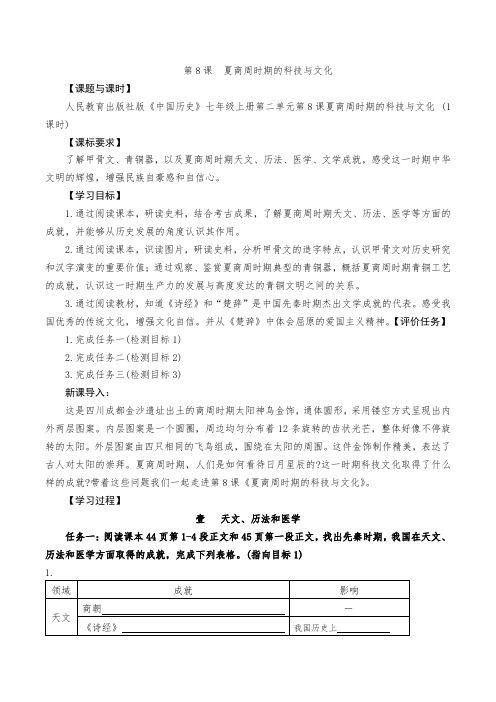
第8课夏商周时期的科技与文化【课题与课时】人民教育出版社版《中国历史》七年级上册第二单元第8课夏商周时期的科技与文化 (1课时)【课标要求】了解甲骨文、青铜器,以及夏商周时期天文、历法、医学、文学成就,感受这一时期中华文明的辉煌,增强民族自豪感和自信心。
【学习目标】1.通过阅读课本,研读史料,结合考古成果,了解夏商周时期天文、历法、医学等方面的成就,并能够从历史发展的角度认识其作用。
2.通过阅读课本,识读图片,研读史料,分析甲骨文的造字特点,认识甲骨文对历史研究和汉字演变的重要价值;通过观察、鉴赏夏商周时期典型的青铜器,概括夏商周时期青铜工艺的成就,认识这一时期生产力的发展与高度发达的青铜文明之间的关系。
3.通过阅读教材,知道《诗经》和“楚辞”是中国先秦时期杰出文学成就的代表。
感受我国优秀的传统文化,增强文化自信。
并从《楚辞》中体会屈原的爱国主义精神。
【评价任务】1.完成任务一(检测目标1)2.完成任务二(检测目标2)3.完成任务三(检测目标3)新课导入:这是四川成都金沙遗址出土的商周时期太阳神鸟金饰,通体圆形,采用镂空方式呈现出内外两层图案。
内层图案是一个圆圈,周边均匀分布着12条旋转的齿状光芒,整体好像不停旋转的太阳。
外层图案由四只相同的飞鸟组成,围绕在太阳的周围。
这件金饰制作精美,表达了古人对太阳的崇拜。
夏商周时期,人们是如何看待日月星辰的?这一时期科技文化取得了什么样的成就?带着这些问题我们一起走进第8课《夏商周时期的科技与文化》。
【学习过程】壹天文、历法和医学任务一:阅读课本44页第1-4段正文和45页第一段正文,找出先秦时期,我国在天文、历法和医学方面取得的成就,完成下列表格。
(指向目标1)1.领域成就影响天文商朝-《诗经》我国历史上《春秋》-历法夏朝,商朝-战国时期,指导农业生产医学战国时期的扁鹊能用,他发明了,一直被中医沿用。
战国时期问世的《》一部重要的中医理论著作。
2.材料:••••原始社会末期商朝周朝春秋《春秋》记录了37次日食。
中国历史夏商周简介及注释

中国历史:夏,商,周(西周,东周)第一章夏朝夏朝(前2146-前1675)夏朝是中国历史上第一王朝。
4000多年前,夏部落首领禹因治水有功,得到了虞【yu2】舜的重用并最终将部落联盟首领之位禅【shan4】让于他,是夏王朝的开端。
大禹死后,其子启即位,即历史上所谓的“大禹传子”,宣告了部落联盟“禅让制”的结束和封建世袭制的开始。
然而夏的统治并不巩固,启在位的时代就发生了伯益叛乱;启之子太康也治国无方,当政期间更是战乱纷纷,最后被东夷的后羿夺取了统治权,史称“太康失国”。
后羿与太康相同,也是一个无能的统治者,终日沉溺于游猎之中,将政事完全交与寒浞【zhuo2】手中。
寒浞掌权后,杀后羿而代之,自立为王。
后,太康弟仲康之孙少康与夏朝遗臣伯靡【mi2】联手,起兵打败寒浞,恢复夏朝的统治地位,史称“少康中兴”;夏朝的统治这才得以巩固,进入了国势向上的相对稳定时期。
自少康以后的杼【zhu4】、槐【huai2】、芒、泄、不【bu2】降【jiang4】、扃【jiong1】、胤【yin4】甲等八代的统治,政治稳定,经济繁荣。
注:不降,一般指姒【si4】不降,又名姒降,夏后不降,谥【shi4】号不降,夏王泄的儿子。
不字在第四声字前念第二声。
到夏代的第13个国王孔甲执政,夏朝开始走向了衰亡。
孔甲“好方鬼神,事淫乱”,引起人民的不满和诸侯的叛乱。
夏朝的统治从此发生危机,只过了四代便导致了亡国之祸。
故而史书记载“孔甲乱夏,四世而陨”(《国语.周语》)。
夏朝的最后一个国王夏桀【jie2】,是历史上一个有名的暴君。
他在位期间,大量驱使百姓为其建造了无数的宫室台榭,又大肆兴兵对外征伐,使得诸侯纷纷离之而去。
而这时,黄河下游的一个夷人部落——商在其首领成汤的领导下兴盛起来。
成汤以讨伐暴君夏桀为名,发动了灭夏的战争;夏桀兵败,死于南巢(今安徽寿县),夏朝宣告灭亡。
夏朝距今大约有4000多年的历史,由于年代久远,加之至今我们仍未发现任何原始的文献与文字记载,故而,我们今日了解夏朝只能从一些上古典籍及一些传说中略知一二。
中国文化概况中英版

中国文化概况中英版An Overview of Chinese Culture (English Version)I. IntroductionChinese culture, with its long history and profound essence, is the sum of material and spiritual cultures created and passed down by the Chinese nation throughout its historical development. Chinese culture emphasizes humanism, focusing on moral values, etiquette, family, and social order.II. Main Contents1. History and EvolutionChinese culture boasts a rich history spanning thousands of years, from the Xia, Shang, and Zhou dynasties to the Spring and Autumn period, the Warring States period, and then to the Tang, Song, Yuan, Ming, and Qing dynasties. It has continuously absorbed and integrated foreign cultures, forming a unique cultural system.2. Traditional ValuesConfucianism is one of the cornerstones of Chinese culture, emphasizing virtues such as benevolence, filial piety, loyalty, and etiquette, which have profoundly influenced the behavior and values of the Chinese people. Taoism emphasizes the harmony between man and nature, advocating a natural and non-interventionist approach. Buddhism, on the other hand, emphasizes compassion and self-sacrifice, having a significant impact on Chinese religion and philosophy.3. Cultural Characteristics- Festival Culture: China has many traditional festivals, such as the Spring Festival, Mid-Autumn Festival, and Dragon Boat Festival, each with unique celebration methods and cultural connotations.- Clothing Culture: Traditional Chinese clothing, such as Hanfu and Tangzhuang, reflects the unique aesthetic concepts and cultural characteristics of the Chinese nation.- Architectural Culture: Traditional Chinese architecture, including palaces, temples, and gardens, is renowned for its distinctive styles and exquisite craftsmanship.- Cuisine Culture: Chinese cuisine, known for its rich flavors and exquisiteculinary techniques, is an important representation of China's cultural charm.4. Influence on the WorldThe values and ideological systems of Chinese culture have had a profound impact on the world, especially Confucianism, which has influenced Asia and beyond. Traditional Chinese arts and forms of expression, such as calligraphy, painting, and Peking Opera, are also deeply loved and admired by people around the world.III. ConclusionChinese culture is a treasure of the Chinese nation, embodying unique charm and value. Through learning and understanding Chinese culture, we can gain a deeper understanding of the history, traditions, and spiritual outlook of the Chinese people, further enhancing our sense of national pride and self-confidence. At the same time, Chinese culture has also made significant contributions to the diversity and development of world culture.中国文化概况中英版一、引言中国文化,源远流长,博大精深,是中华民族在长期历史发展过程中所创造并传承下来的物质文化和精神文化的总和。
中国传统历史文化历史的发展顺序

中国传统历史文化历史的发展顺序中国传统历史文化是华夏族群在漫长的历史进程中所积淀的,经历了数千年的发展和演变。
以下将以时间顺序为主线,介绍中国传统历史文化发展的大致轨迹。
1. 夏商周时期(公元前2000年-公元前221年)夏商周时期是中国古代历史的开端,按照传记记载,大禹开创了夏王朝,成为中国历史上的第一个统一政权,建立了最早的农耕社会。
商王朝取得了对黄河流域的统治,并发展出独特的文字——甲骨文。
周王朝取代了商王朝,采用封建制度并制定了“九州”的划分,部分地形成了奴隶制度。
2. 春秋战国时期(公元前770年-公元前221年)春秋战国时期是中国历史上一个动荡不安的时期,也是思想文化蓬勃发展的时期。
在这个时期,儒家、道家、墨家、法家等学派纷纷涌现,提出不同的政治和社会观念,对后世产生了深远的影响。
同时,大量的历史、哲学、文学著作也在这个时期诞生,如《左传》、《国语》、《庄子》等。
3. 秦汉时期(公元前221年-公元220年)秦始皇统一了六国后,建立了中国历史上第一个中央集权的王朝——秦朝。
他推行了一系列改革措施,如统一度量衡、文字、货币等,进一步巩固了统一的国家体制。
然而,秦朝的暴政也导致了民众反抗和起义,最终秦朝灭亡。
随后,西汉王朝建立,继续发展了中央集权制度,并在科技、文化和艺术方面取得了许多重要成就。
4. 魏晋南北朝时期(公元220年-589年)魏晋南北朝时期是中国历史上政治分裂最为严重的时期之一。
各个政权频繁更迭,社会动荡不安。
然而,在这个时期,佛教从印度传入中国,对中国文化产生了深远的影响。
瓷器和造纸术的发明也让中国的科技水平得到了进一步提升。
5. 唐宋元明清时期(618年-1912年)唐朝是中国历史上的鼎盛时期之一,国力强盛,文化繁荣。
唐朝的诗词、绘画等艺术成就享誉世界。
宋朝在政治、军事和文化方面取得了一系列重要成就,如科技进步,包括火药的发明。
元朝是蒙古族建立的王朝,他们带来了许多新的事物和文化,如蒙古包、北方民歌等。
中国文明史课程教学大纲
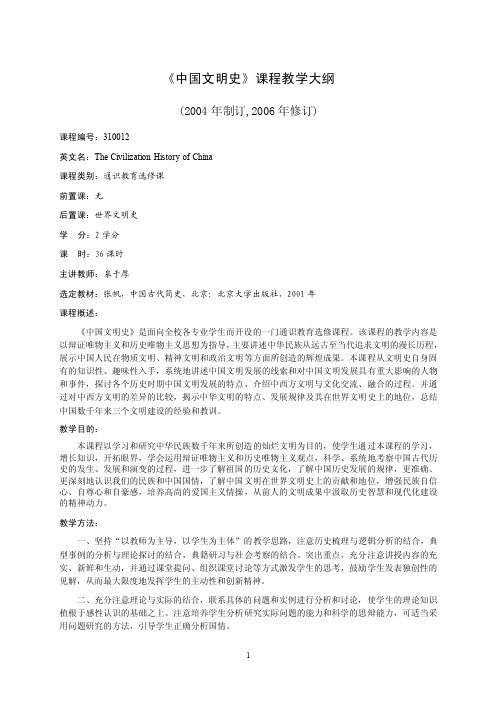
《中国文明史》课程教学大纲(2004年制订,2006年修订)课程编号:310012英文名:The Civilization History of China课程类别:通识教育选修课前置课:无后置课:世界文明史学分:2学分课时:36课时主讲教师:皋于厚选定教材:张帆,中国古代简史,北京:北京大学出版社,2001年课程概述:《中国文明史》是面向全校各专业学生而开设的一门通识教育选修课程。
该课程的教学内容是以辩证唯物主义和历史唯物主义思想为指导,主要讲述中华民族从远古至当代追求文明的漫长历程,展示中国人民在物质文明、精神文明和政治文明等方面所创造的辉煌成果。
本课程从文明史自身固有的知识性、趣味性入手,系统地讲述中国文明发展的线索和对中国文明发展具有重大影响的人物和事件,探讨各个历史时期中国文明发展的特点,介绍中西方文明与文化交流、融合的过程。
并通过对中西方文明的差异的比较,揭示中华文明的特点、发展规律及其在世界文明史上的地位,总结中国数千年来三个文明建设的经验和教训。
教学目的:本课程以学习和研究中华民族数千年来所创造的灿烂文明为目的,使学生通过本课程的学习,增长知识,开拓眼界,学会运用辩证唯物主义和历史唯物主义观点,科学、系统地考察中国古代历史的发生、发展和演变的过程,进一步了解祖国的历史文化,了解中国历史发展的规律,更准确、更深刻地认识我们的民族和中国国情,了解中国文明在世界文明史上的贡献和地位,增强民族自信心、自尊心和自豪感,培养高尚的爱国主义情操,从前人的文明成果中汲取历史智慧和现代化建设的精神动力。
教学方法:一、坚持“以教师为主导,以学生为主体”的教学思路,注意历史梳理与逻辑分析的结合,典型事例的分析与理论探讨的结合,典籍研习与社会考察的结合。
突出重点,充分注意讲授内容的充实、新鲜和生动,并通过课堂提问、组织课堂讨论等方式激发学生的思考,鼓励学生发表独创性的见解,从而最大限度地发挥学生的主动性和创新精神。
- 1、下载文档前请自行甄别文档内容的完整性,平台不提供额外的编辑、内容补充、找答案等附加服务。
- 2、"仅部分预览"的文档,不可在线预览部分如存在完整性等问题,可反馈申请退款(可完整预览的文档不适用该条件!)。
- 3、如文档侵犯您的权益,请联系客服反馈,我们会尽快为您处理(人工客服工作时间:9:00-18:30)。
Yellow Emperor
Huang Di or the Yellow Emperor, is a legendary Chinese sovereign and cultural hero presented in Chinese mythology. He is said to be the ancestor of all Huaxia Chinese. According to many sources he was one of the legendary Three Sovereigns and Five Emperors. Tradition holds that he reigned from 2697–2597 BCE or 2696–2598 BCE. He is regarded as the founder of Chinese civilization.
Yu the Great
Yu the Great (大禹 Dà-Yǔ), was the legendary founder of the Xia Dynasty that began in 2205 BCE. He is best remembered for teaching the people techniques to tame rivers and lakes during an epic flood. The Xia era would also go down as the first dynasty in what would later become China with his son Qi following after his reign. Yu is one of the few Chinese ruler posthumously honored with the appellation "the Great".
The Zhou Dynasty was the longest-lasting dynasty in Chinese history, from 1066 BC to approximately 256 BC. The ruler of the Zhou, King Wu, with the assistance of his brother, the Duke of Zhou, as regent, managed to defeat the Shang at the Battle of Muye. The king of Zhou at this time invoked the concept of the Mandate of Heaven to legitimize his rule.
A Brief Introduction to the Histn Emperor
The Yan Emperor, or Yandi, (Chinese: 炎帝; pinyin: Yán dì; literally: "Flame Emperor") allegedly lived in China about 4,000 years ago. According to a folk tale, Shennong was the first Chinese tribe. The Yan Emperor was a descendant of Shennong. Or, more likely, the term Flame Emperor was a title, held by dynastic succession, with Shennong, at least posthumously, being known as Yandi.
Xia Dynasty (ca. 2100-ca. 1600 BC)
The Xia Dynasty of China (from ca. 2100 BC to 1600 BC) is the first dynasty to be described in ancient historical records
Shang Dynasty (ca. 1700-1046 BC)
Shang Dynasty was divided into two sets: 1. The first set, f rom the earlier Shang period comes from sources at Erligang, Zhengzhou and Shangcheng. 2. The second set, from the later Shang or Yin (殷) period, 殷 consists of a large body of oracle bone writings. The Shang Dynasty featured 31 kings, from Tang of Shang to King Zhou of Shang.
.
The historian Sima Qian (145-90 BC), who wrote the Shiji or Records of the Grand Historian, and the so-called Bamboo Annals date the founding of the Xia Dynasty to 4,200 years ago . According to mythology, the dynasty ended around 1600 BC as a consequence of the Battle of Mingtiao.
Western Zhou
King Wu founded the system of enfeoffment (of the Western Zhou Dynasty, c. 11 th. century-771 B.C., investing the nobility with hereditary titles, territories and slaves); enfeoffment system; feudal system of land-holding. Founded the feudal and patriarchal clan system. Founded the etiquette and politeness system.
the Chinese worshipped many different gods - weather gods and sky gods - and also a supreme god, named Shangdi, who ruled over the other gods. Around 1500 BC, the Chinese began to use written oracle bones to predict the future. Shang Dynasty moved its capital six times. The final (and most important) move to Yin in 1350 BC led to the dynasty's golden age. The skills of making bronze work was developing
fast.
Zhou Dynasty (1066-256 BC)
--Western Zhou (1066-771 BC) Eastern Zhou (770-256 BC):Spring and Autumn Period (722476 BC), Warring States Period (476-221 BC)
